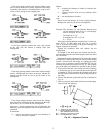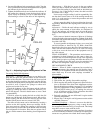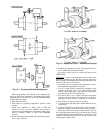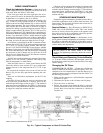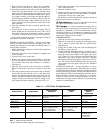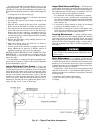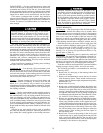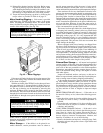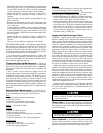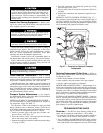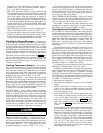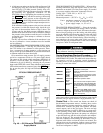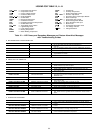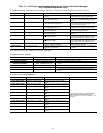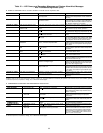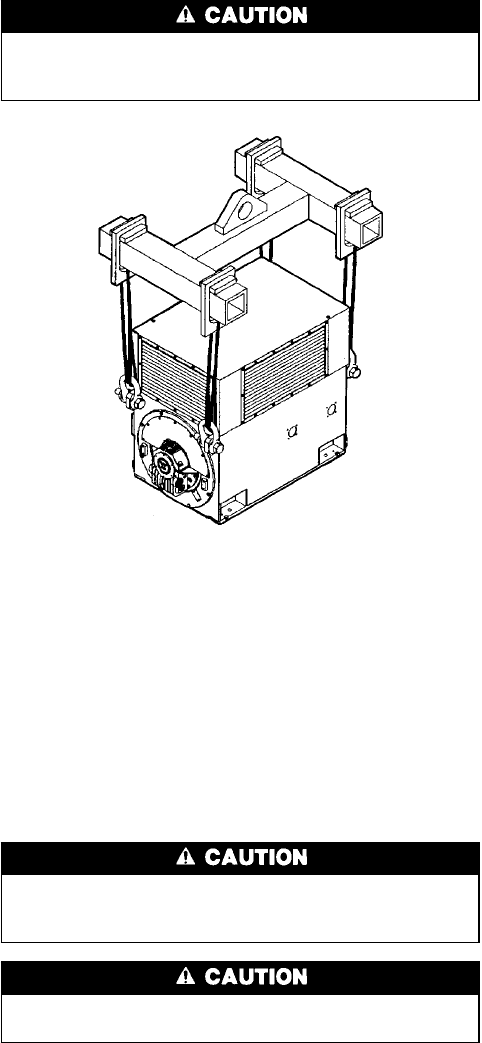
14. Reinstall the bearing housing split bolts. Before torqu-
ing bearing housing cap bolts, rotate the shaft by hand
while bumping the bearing housing with a rubber or raw-
hide mallet in the horizontal and axial planes to allow
the bearings to align themselves to the shaft journals.
15. Torque the bearing housing cap bolts by following the
torque values as provided in Table 6 on page 51.
Motor Handling/Rigging — Each motor is provided
with lifting lugs, welded to the four corners of the motor
frame, for lifting the assembled chiller. The motor should
always be lifted by using the lifting lugs located on all four
corners of the motor frame. (See Fig. 46.)
Spreader bars of adequate capacity and number must be
used to avoid applying any pressure against the top air
housing with the lifting plugs.
If the motor is lifted with the top air housing removed, the
angle of the lifting slings with the horizontal should never
be less than 45 degrees.
With the exclusion of the TEWAC cooler, the top air hous-
ing is provided with
3
⁄
4
-10 tapped holes for lifting devices to
be installed in order to remove the air housing from the mo-
tor. The top air housing can be detached by removing the
enclosure holddown bolts, located in the inside corners of
the enclosure. These enclosure holddown bolts are accessed
through the louver/screens located on the front and rear end
of the chiller or through access panels bolted to the sides of
the enclosure.
Uneven lifting must always be avoided. When single
point lifting is to be used, slings of equal lengths must
always be used to avoid uneven lifting.
Under no circumstances should the motor be lifted us-
ing the shaft as an attachment point.
NOTE: Refer to weights specified on certified drawing to
determine proper lifting equipment required for specific com-
ponents or assemblies.
Motor Storage — If the chiller is to be placed in ex-
tended shutdown, certain precautions must be taken to
provide proper protection while the motor is being stored.
The motor should be stored under cover in a clean, dry lo-
cation and should be protected from rapid temperature changes.
Since moisture can be very detrimental to electrical com-
ponents, the motor temperature should be maintained at ap-
proximately 5° F (3° C) above the dew point temperature by
providing either external or internal heat. If the motor is
equipped with space heaters, they should be energized at the
voltage shown by the space heater nameplate attached to the
motor. Incandescent light bulbs can be placed within the mo-
tor to provide heat. However, if used, they must not be al-
lowed to come in contact with any parts of the motor because
of the concentrated hot spot that could result.
This motor has been provided with a shaft shipping brace
or shipping bolt (normally painted yellow) to prevent shaft
movement during transit, it must be removed to allow shaft
rotation (refer to Before Initial Start-Up, Remove Shipping
Packaging section, page 45). It is very important that this
brace be reinstalled exactly as it was originally, before the
motor is moved from storage or any time when the motor is
being transported. This prevents axial rotor movement that
might damage the bearings.
Motors equipped with sleeve bearings are shipped from
the factory with the bearing oil reservoirs drained. In stor-
age, the oil reservoirs should be properly filled to the center
of the oil level gage with a good grade of rust inhibiting oil
(refer to the certified drawing for oil viscosity and any spe-
cial requirements). To keep the bearing journals well oiled
and to prevent rusting, the motor shaft should be rotated sev-
eral revolutions every 2 weeks. While the shaft is rotating it
should be pushed to both extremes of the endplay to allow
for oil flow over the entire length of the journals.
External Gear Storage — All internal and unpainted
external surfaces of the gear drives have been treated with a
rust preventative at the factory before shipment. The pro-
tective life of the rust preventative varies with temperature
fluctuations, atmospheric moisture content, degree of expo-
sure to the elements during storage, and degree of contact
with other objects.
Inspect all machined surfaces, and spray or add rust in-
hibitor to exposed metal surfaces that may have had the pro-
tective coating removed during shipping and handling.
To be sure that the gear drive operates satisfactorily at start-
up, take certain precautions when you receive it. The ex-
pected length of storage and the storage atmosphere dictate
the maintenance schedule to be followed. The gear must al-
ways be stored in its operating position, level on its mount-
ing feet, and free of loads or weights on input and output
shafts.
SHORT-TERM STORAGE (Indoors) — If the units are to
be stored for 30 days or less, observe the following precau-
tions.
• Store the unit in a clean, dry location with the factory pack-
ing intact and with as nearly a constant temperature as
possible.
• Elevate the unit a minimum of 6 in. above the floor level.
• Avoid areas that are subject to extremes in temperature,
vibration, and humidity.
LONG-TERM STORAGE (Indoors) — If the unit is to be
stored for more than 30 days, observe the following precau-
tions. Store in a clean, dry location. Elevate the unit at a
minimum of 6 in. above the ground floor level. Avoid areas
that are subject to extremes in temperature, vibration, and
humidity. In addition, do one of the following:
• Remove the breather and replace it with pipe plugs. Pack
the entire seal area with grease to form a vapor barrier and
seal with tape.
Fig. 46 — Motor Riggings
81



